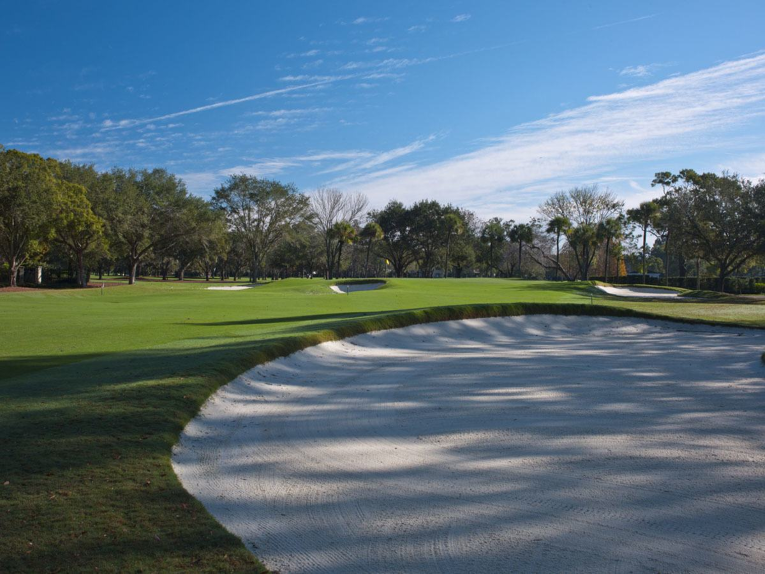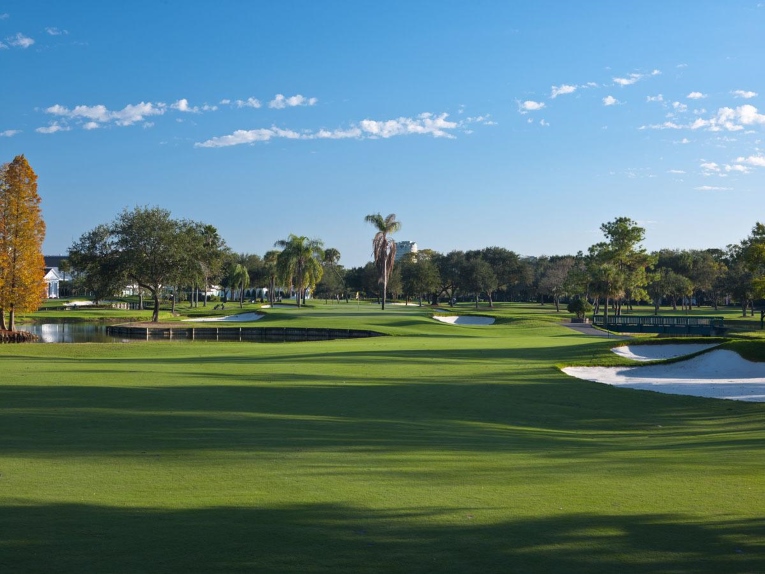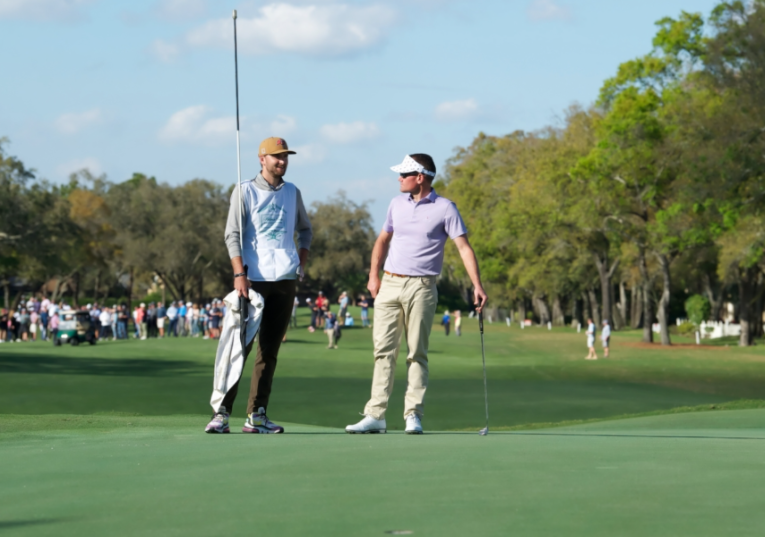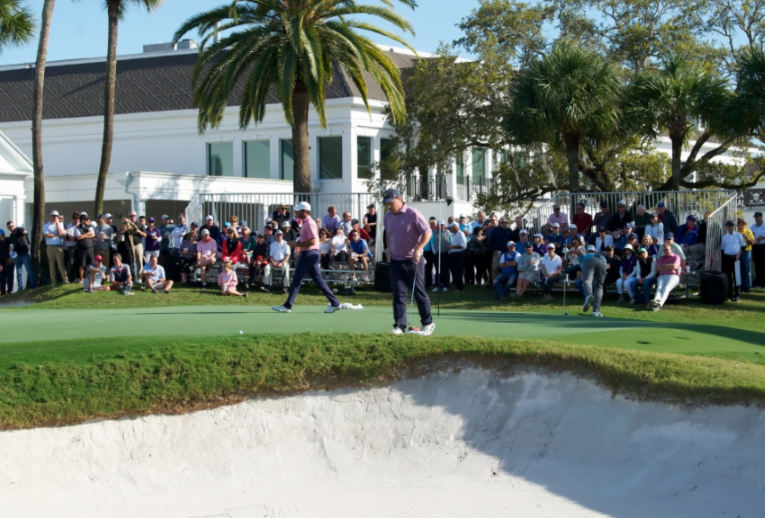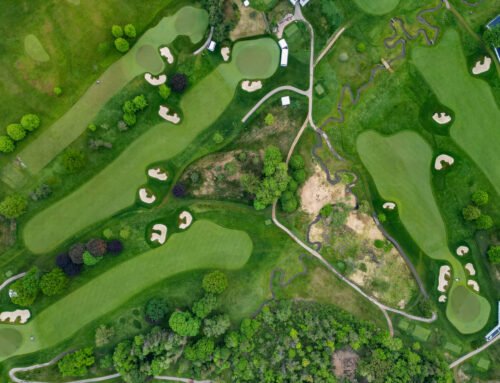Palma Ceia Golf & Country Club, 1916
Tampa, Florida
by
Walker Thomas
April, 2021
Introduction
The history of Palma Ceia is quite extensive but also unknown to those outside of the Tampa area. Palma Ceia is the first private club in Tampa, home to the competitive Mid-Am, Gasparilla Invitational, and was the founding club of the LPGA. Prominent people involved in the Club over the years are Donald Ross, Tom Bendelow, Walter Hagen, Fred Ridley, Gene Sarazan, Bob Ford, Bobby Weed, and sports’ greatest “Babes” – Ruth and Zaharias.
Palma Ceia seems to be one of the great hidden gems of the golf world. The course is fairly short relative to modern courses with a par 70, topping out at just over 6300 yards, brilliantly routed through an 82-acre parcel of land. It may seem like a piece of cake to the scratch player who looks at the scorecard for the first time, but the ancient looming oak trees and subtlety challenging and slick greens act as the defense mechanism for the course. Because of the great routing by Bendelow/Ross, the course, even though built on such limited land, never feels cramped or overcrowded by trees and other golfers. Due to the very short green to tee distances and walkable routing, I put Palma Ceia up against any other as one of the best walking courses in the country.
Gil Gonsalves, Head Golf Professional for 35 years (1974-2008), who grew up on the Mid Ocean Club, has this to say about Palma Ceia and The Gasparilla Invitational, ‘The Gasparilla Invitational gained a lot of momentum in the early 80’s when the likes of Dick Siderowf, a two-time British Amateur Champion came to compete at Palma Ceia. Gasparilla became a serious event for great golfers which included several U.S. Champions. These Champions who over the years were eligible for The Masters, in their own words said that ‘the Gasparilla was a great Tune-Up for the April event since Palma Ceia’s green speeds closely resembled Augusta’s.’
History of Palma Ceia
In 1915 there were only a handful of golf courses in the Tampa Bay area and the closest one to the city being The Tampa Auto and Golf Club at Rocky Point, now the municipal Rocky Point Golf Course. A group of 18 men felt as if there was a need for a quality golf club closer to the Tampa city limits, which now had a population of 48,160 (1915 Census), which stood as the second largest city in the state behind Jacksonville.
The Tampa Tribune provided thorough coverage of the founding and construction of Palma Ceia. A feature article was published about the Founding Members of the club. We can see the strong connection between Rocky Point and Palma Ceia with five connections to the founding of the club, including the president of Rocky Point Club.

A rustic picture of the course from July of 1919
Courtesy, Tampa-Hillsborough County Public Library System.
Tampa’s unique geography and the pattern of suburban growth allowed the founders of Palma Ceia to build their club closer to town than in most other cities. You can see today on a map, Palma Ceia is right in the center of the city. The Tribune described it in glowing terms. “The new course is admirably situated with reference to the city proper, to the Tampa Bay Hotel (which is now The University of Tampa), the city’s chief tourist resort, and to the Tampa Yacht and Country Club.” Tampa seemed to grow around Palma Ceia, as it is still the center of South Tampa. Many younger club members would take the Port Tampa streetcar to the stop at Bayshore and Barcelona and then cut through the woods to the golf course.
The original terms called for the group to lease the 100 acres for $1 per year and pay the annual property taxes. There was an option to purchase the golf course land after 10 years for $150,000. And so, Palma Ceia Golf and Country Club became a reality under the leadership of an original 10-man group that included Dr. J.B. Wallace, M.G. Gibbons, S. F. Knight, James T. Swann and Dr. J. B. Farrior. The group accepted the lease and constructed the golf course and a small clubhouse. They began business by offering memberships that specified an initiation fee of $25 (which was generally waived) and monthly dues of $3.50.
Architectural Evolution of Palma Ceia’s Golf Course
The club leaders pledged to spend $100,000 ($2.56 million today) on the course and clubhouse, situated on just 82 pine-covered acres. The committee reached out to Tom Bendelow to design the new course in 1916. Bendelow routed the course through the pine trees and sandy soil and visited the site several times during construction. Bendelow declared the course, “one of the sportiest natural hazard courses in the country.” The length came out to 6,400 yards second in length in the country only to Audobon Golf Club in New Orleans at 6,500 yards. Palma Ceia’s length has roughly stayed the same over the years. Interesting to point out that neither courses are known for their length anymore, with Audobon now a par of 62 at 4200 yards in length after a renovation by the city of New Orleans.
In an interview with The Tampa Tribune, Bendelow gave a description of the course and its environs. “The course is built in a small forest; the fairways and greens being cleared and winding trails from green to tees. Besides proving delightful settings for a golf course, the trees, many of them hundreds of years old, have been utilized as hazards, and in these one or two instances will prove admirable traps. The greens are all of grass and no two are alike, nor will the same shots suffice for any two holes. The course will keep the best of them hard at work and it will require the use of every club in one’s bag for its successful negotiation.”
In April of 1923 the Club’s Board voted unanimously to spend $15,000 to hire Donald Ross as architect to renovate the course. Ross had already built three courses in Belleair, FL (only two still exist) across Old Tampa Bay in 1915 and The Country Club of Orlando in 1918. Ross would go on to design Timuquana Country Club in Jacksonville, FL in the same year, so he would be familiar with the area. Ross sent Walter Hatch, who was hired in 1918 as Ross’ assistant, to oversee the construction process. This was typical of Ross sending an assistant under him to supervise construction as Ross was one of the most prolific architects of The Golden Age, having over 400 courses to his name (Number taken from The Donald Ross Society). Ross changed the routing a little bit and added more bunkers to the course, but generally kept the playing corridors the same.
Most of the playing corridors were kept generally the same.

In a 1928 Tampa Tribune article, the Palma Ceia Greenskeeper, J.P. Dunn, and The Greens Committee, added 30 to 40 bunkers, five years after Ross came to renovate the course. The article is titled “Palma Ceians’ Worst Fears Confirmed As New Bunkers Planned”
In 2009 the board called upon Bobby Weed, an apprentice of Pete Dye, to bring back the Ross features of the course and to undo some poor renovative projects done in the past. Weed reinstalled the entire drainage system, which brought back lots of rolling fairways and fed water to drains in low points in the fairway. Weed also added flawless green to tee transitions with short grass carrying over from the fringe to the next tee box. Weed added a long bunker along the inside of the left dogleg on the 393-yard par 4 sixth, transforming the hole into a tough drive off the tee. Below are pictures taken from Weed’s website after the renovation.
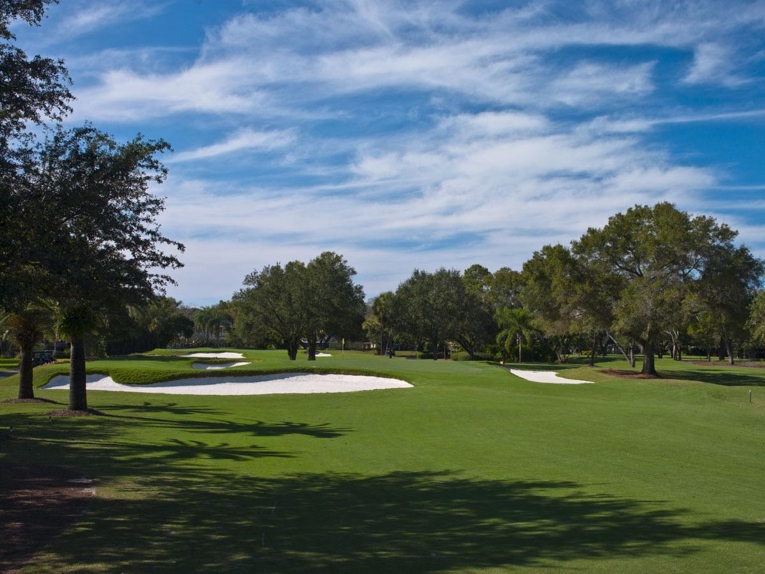
Looking at the green from the left side of the fairway on the par 5, 3rd hole. The 130 yard 4th is visible in the background.
Bobby Weed’s work won renovation of the year in 2012 by Golf Inc.
The Gasparilla Invitational and Amateur Golf
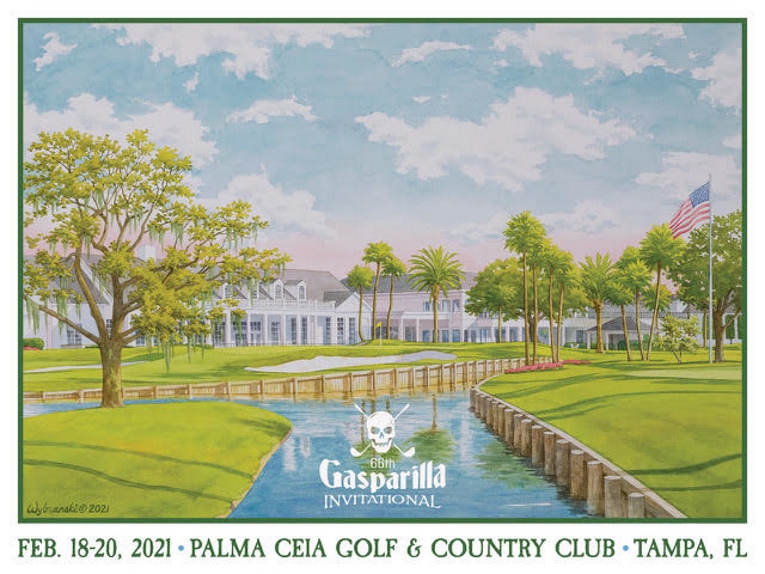
A poster for the 2021 Gasparilla Invitational. The Club commissioned Lee Wybranksi to do the work. The painting is done standing in front of the 14th tee box looking at 18 green with the clubhouse behind.
2021 Senior Champion, Brian Keenan (+3, 213) and 2021 Mid-Am Champion, Chip Brooke (-5, 205) Palma Ceia Golf & Country Club is committed to hosting a Mid/Senior Amateur Golf Tournament comprising one of the most elite fields in amateur golf. With an extensive tournament history, the Club has hosted very competitive fields in the past featuring players such as 1986 US Am Champion Buddy Alexander, 2017 US Mid-Am Champion Matt Parziale, 2019 US Senior-Am Champion Bob Royak, and many more. The event has become one of the members’ most looked forward to events of each year, as they watch some of the game’s greatest amateurs play their home course in it’s best conditions. The tournament is open to the public too.
Palma Ceia has held amateur tournaments every year since its opening in 1916. When it was a professional tournament it held the largest purse on the PGA tour. On February 18, 1932 with a 36-hole qualifying round, 152 professionals battled to make the cut with only 32 golfers left to compete for the $4,000 purse. The Gasparilla Open became a sanctioned PGA tour event, the first winner being Paul Runyan, who went on to compile 29 PGA Tour victories in his 11-year run. Gene Sarazen competed in the 1932 Gasparilla Open, though he did not win that Gasparilla, he did later that year win the 1932 Open Championship and US Open. He went on to win seven majors and thirty-one PGA tournaments.
The Gasparilla Open returned in 1933 with Denny Shute claiming the victory along with The Open Championship played in St. Andrews later that year. In 1934 Shute would win the Gasparilla again. Walter Hagen’s dramatic win at the 1935 Gasparilla is detailed in the section below. This was not only Hagen’s final PGA win, but it was the final Gasparilla Open itself, due to the damaging effects of the Great Depression. The Gasparilla Invitational returned several years later after the recovery of the Great Depression.
Years later in February of 1956, The Gasparilla came back as an amateur invitational. Since the first tournament in 1956, many US Amateurs and Mid-Amateur champions, as well as Walker Cup players, have chosen to add this tournament to their playing schedules.
When the Gasparilla Invitational became more connected to the Mid-Amateur event format, the rules stipulated that the participant had to be at least 25 years of age and no longer in college to compete. A long list of US Mid-Am Champions have participated and won the Gasparilla Invitational, including top amateurs Tim Jackson, Spider Miller, and Danny Green. It was not uncommon for USGA Champions to compete in the Gasparilla Invitational as a way to prepare them for the fast putting surfaces and pressure filled environment that they would encounter in just a few weeks later in April at Augusta National. The slickly quick putting surfaces and narrow fairways have fiercely protected par every year. In fact, par has only been broken eight times by winners of the 54-hole tournament. This past year, in 2021, Chip Brooke shot 5 under par (270), with only one other player in the field breaking par that year.
As the host club of the tournament it should be noted that The Gasparilla has been won by its own members over the years. Three Palma Ceia members have won the event over the years. Though he never won, Palma Ceia’s own, and US Amateur winner Fred Ridley has participated in and served as Chairman of the tournament.
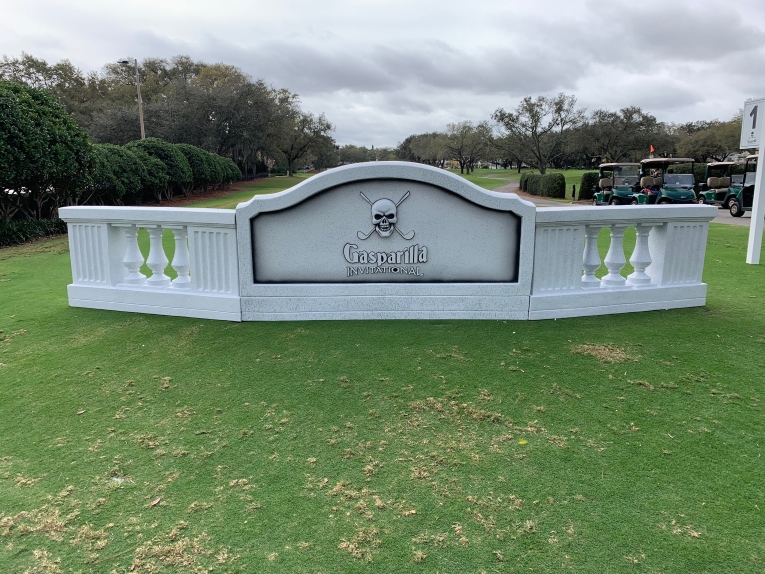
The Gasparilla Invitational has also been voted by Amateurgolf.com as one of the best logos in amateur golf.

The Gasparilla Invitational Trophy is a skull and crossbones made of golf clubs, resembling Tampa’s roots to pirating and Palma Ceia’s close ties to the YMKG (Ye Mystic Krewe of Gasparilla).
Professional Golf at Palma Ceia
From the club’s inception through the 1940’s, Palma Ceia was a center for many golf tournaments, with many of the world’s greatest professional players using Palma Ceia as a hub of operations. The club played host to such famous players as Gary Player, Horton Smith, Ralph Guldahl, Ray and Lloyd Mangrum, “Wild Bill” Melhorn, Billy Burke, Willie Macfarlane and Henry Picard. Paul Runyon and Johnny Revolta won their first tournaments at Palma Ceia. James “Long Jim” Barnes, one of the 12 original inductees into the PGA Hall of Fame, was briefly employed as a pro in 1916 and 17. Bob Ford, head professional of Seminole Golf Club, worked in the Pro Shop while at the University of Tampa.
The great Walter Hagen was employed as Palma Ceia’s winter professional in 1919, and played a number of well-publicized exhibition matches at the club while in that role, including a homegrown professional event styled The National Midwinter Open, which of course Hagen won. Hagen then went on that summer to win his second U.S. Open title. Between 1932 and 1935, the Gasparilla Open was a PGA tour event. Fittingly, Hagen at age 42 returned to Palma Ceia for the 1935 Gasparilla, and there he won his last individual PGA tournament with dramatic birdies on 17 and 18, capping his legendary career (full story in the Hagen section).
The sand bunker adjacent to the No. 9 green is famous as the location where Gene Sarazen perfected the first sand wedge club, which he crafted by adding a flange to a pitching wedge. He was assisted in this project by Harry Root, Jr., 6-time club champion and a highly accomplished golfer in his own right. Additionally, the club has played host to many state and city championships and national qualifying rounds.
In February of 1964, Arnold Palmer and Jack Nicklaus came to Palma Ceia to play an exhibition match. They both came over from Delray, Florida where the day before Nicklaus shot a 67 at Pine Tree. Below is a newspaper clipping from the St. Petersburg Times detailing how Nicklaus and Palmer played each hole. The Tampa Tribune pictures Palmer and Nicklaus the day before from Delray and another clip of Palmer staring down a drive at Palma Ceia.
Walter Hagen
One of the greatest golfers of all time, “Sir Walter” Hagen popularized professional golf and brought it into the mainstream of global sport. In 1919, some 16 years before the 1935 Gasparilla, 26-year-old Walter Hagen was employed as Palma Ceia’s winter professional, with the Club also serving as his home course as he played the Florida winter circuit. At that time, he only had 3 tournament wins, although one of them was the 1914 U.S. Open. When Hagen returned to Palma Ceia for the 1935 Gasparilla, he was the holder of 43 PGA titles and 11 Majors and was recognized as the greatest professional golfer of his era. He was also 42 years old and had not won a tournament in 2 years. Nevertheless, the organizers held a spot for him, although they were unsure if he would attend, because he did not show up for any practice rounds.
In his autobiography chapter entitled “Gasparilla,” Hagen recounts how at dawn on the morning of the first round of the tournament, he found himself across the Bay at the Belleview-Biltmore Hotel, still attired in his tuxedo after an all-night party. To prepare for his upcoming play, he sent his chauffeur into a field beside the hotel to retrieve a few practice shots. After topping three shots in a row, he decided that was enough practice, and headed off to Tampa, briefly interrupted by a flat tire on the Gandy Bridge. Just two minutes before his 9:00 tee time, Hagen was spotted as he sauntered up to the first tee to play without a single practice swing or putt. He then proceeded to shoot a course record 64 and take the tournament lead.
Back then, the final two rounds were played consecutively on the third day of the Tournament. After making a seven on the short par five 18th hole in the 3rd round, Hagen retired for a brief respite only two up on the field. He then posted a 38 on the front side of the final round which put him in a tie with just nine holes left to play. By the time he stepped onto the par three 17th tee, he was one stroke behind the clubhouse leader, Clarence Clark, and appeared likely to lose, especially after his tee shot landed 45 feet from the pin. However, as the New York Times reported the next day, he “nonchalantly” holed the long birdie putt before a cheering crowd to tie for the lead. He then birdied 18 with an up and down from the bunker to capture his final PGA individual victory.

Walter Hagen is pictured at Palma Ceia above on the right The Birthplace of Women’s Professional Golf (LPGA)
The Birthplace of Women’s Professional Golf
Women’s golf burst on the scene in the 1940’s and Palma Ceia was at the forefront. Through the efforts of members Sam Davis and Harry Root, Jr. along with the Tampa Chamber of Commerce, Palma Ceia began staging a women’s event called the Tampa Women’s Open. At that time there were only about a dozen women golf professionals and only two or three tournaments where they competed with the top women amateur players. It was at these early Palma Ceia women’s tournaments where women’s golf began to catch on as a spectator sport. Palma Ceia earned particular recognition in 1948 when, during a women’s tournament, some players met at the club to discuss forming the Ladies Professional Golfers Association (LPGA). It wasn’t long before the LPGA had such stars as Babe Zaharias, Louise Suggs, Patty Berg and Betty Jameson in its roles. The first LPGA tournament was the 1950 Tampa Women’s Open at Palma Ceia Golf & Country Club. The players reportedly loved Palma Ceia more than any other Club, but in 1960 the club’s planned new clubhouse imposed restrictions during construction and thus ended the run of the women’s tournament. Babe Zaharias won the first Tampa Women’s Open in 1947 as an amateur.
To this day women’s golf thrives at Palma Ceia. With the course closed for maintenance on Mondays, leading off the week every Tuesday, tee times are reserved for women until 1:00.

Three women and their caddies on the tee at Palma Ceia (1936) Courtesy, Tampa-Hillsborough County Public Library System.

Four women and their caddie on the green at Palma Ceia (1936) Courtesy, Tampa-Hillsborough County Public Library System.

Four junior girls and their caddie on the green at Palma Ceia (November 1939) Courtesy, Tampa-Hillsborough County Public Library System.
Winners of the Tampa Women’s Open:
- 1960 — Mickey Wright
- 1959 — Ruth Jessen
- 1958 — Betsy Rawls
- 1957 — Betsy Rawls
- 1956 — Betsy Rawls
- 1955 — Babe Zaharias
- 1954 — Betsy Rawls
- 1953 — Louise Suggs
- 1952 — Louise Suggs
- 1951 — Babe Zaharias
- 1950 — Polly Riley (First LPGA tournament)
- 1949 — Patty Berg
- 1948 — Betty Jameson
- 1947 — Babe Zaharias
The Clubhouse
In Palma Ceia’s 105-year history, the club has only had two main clubhouse buildings. The original clubhouse was designed by Tampa architect M. Leo Elliot, for which the Club budgeted $16,000 ($325,000 today). Elliot also designed the Tampa YMCA, Centro Asturiano in Ybor City, and the Tampa City Hall. It seems likely from the design that Elliot keyed in on the “house” part or clubhouse as he designed Palma Ceia’s building in the style of a bungalow. Both the front and back elevations featured large open porches. Brick columns supported the three-story structure. The original building had features one would expect in a clubhouse, but it also included a small bowling alley.

Palma Ceia’s Original Clubhouse designed by M. Leo Elliot (1924) Courtesy, Tampa-Hillsborough County Public Library System

The Centro Asturiano in Ybor City (built in 1902), a social club for descendants of immigrants from Spain designed by M. Leo Elliot, the architect of Palma Ceia’s clubhouse. It was added to the US National Register of Historical Places in 1974.
In 1932, the club added a new dance floor and stage for live bands, this was added on outside by Elliot. Only minor changes were added from this time until after the war in the late 1940’s, when the membership started to dramatically increase and lean more towards non-golf, event-oriented wants and needs. In the late 40’s the kitchen was enlarged. Around this time is when the architectural style of the clubhouse changed from a bungalow style to a colonial style clubhouse. In 1952, a new pro shop was constructed at the same location as the original. Additionally, a small caddy shack was built as well.
In 1960, the club decided it cannot keep on adding to the original building and that they needed a whole new clubhouse from the ground up. The new $750,000 clubhouse opened April 29, 1962. This is when the style changed from bungalow to more of a colonial-style clubhouse. Though heavily altered through additions and remodels, this is still the same clubhouse that is still in use today. The four tennis courts were rebuilt in 1966.
The first remodeling project came in 1983 and consisted of $250,000 worth of improvements, such as work on the Men’s Grill and Card Room and the new carpets. In 2009, a new golf pro shop was built as Bobby Weed was renovating the golf course. In 2015, the clubhouse again experienced renovations, including a complete reconstruction of the 19th Hole, the formal dining room (renamed Bendelow’s in honor of the original course designer), and the bar. Peacock and Lewis based in North Palm Beach was the consulting architect for the interior redesign. Peacock and Lewis’ past projects include work at Muirfield Village, Jupiter Hills, Mountain Lake, TPC Sawgrass, The Bear’s Club, Lost Tree Club, John’s Island Club, Ocean Reef Club, and many more. They will also be working with Palma Ceia on the new pool redesign. Below are a few pictures of the clubhouse renovation, courtesy of Peacock and Lewis.
In the next year (2021), the membership looks forward to the total reconstruction of the pool area which has remained basically untouched since 1997.
For More Information Most of my information in this article comes from newspaper clippings available online, the Gasparilla Invitational website, and Palma Ceia Golf and Country Club: A Centennial Celebration which was mailed to the membership in 2016. For more information about Palma Ceia history, The Gasparilla invitational, its history, tournament field and results, videos and pictures from the event, refer to the Gasparilla Invitational website or feel free to contact me at walkerwwt2000@gmail.com.
Sources
https://gasparillainvitational.com/
https://www.amateurgolf.com/amateur-golf-tournaments/1517/Gasparilla-Invitational
https://www.amateurgolf.com/golf-tournament-news/23681/The-Best-Tourname nt-Logos-in-Amateur-Golf
https://en.wikipedia.org/wiki/Gasparilla_Open Kite-Powell, Rodney, et al.
Palma Ceia Golf and Country Club: A Centennial Celebration. Rinaldi Printing, 2016.
http://www.peacockandlewis.com/projects/interiors/palma-ceia-golf-country-club










